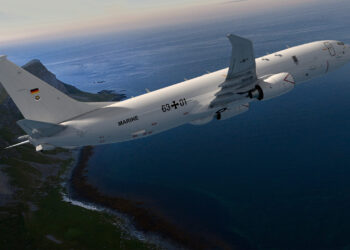,
BREMEN, Germany: A quantum leap in maritime communications technology is on the way. In future, naval vessels will be able to interconnect their combat systems and, for example, exchange large quantities of reconnaissance data in real-time.
This unique and hitherto unavailable high-speed network for ships will be offered by ATLAS ELEKTRONIK, a leading supplier of naval electronics, as part of a strategic cooperation with Tesat-Spacecom and Synopta.
An agreement to this effect was signed recently by the three companies.
In this way, operational forces will be able to update their tactical situation pictures without any time lag, enabling them to respond immediately to possible dangers and threats. The new capability will enhance the security of the ships and their crews considerably.
For this programme, the three partners are developing an innovative hybrid technology: a radio connection with a very high bandwidth is supplemented by an integrated optical link offering an extremely high bandwidth. This hybrid connection is available during all weather conditions, and forms the backbone of the high-speed link. Besides speed of transmission, the focus of development is also on reliability.
The system is being designed for reliable and automatic operation on naval vessels and also for easy integration on board.
Amongst other features, the new high-speed link permits the continuous transmission of real-time reconnaissance videos between two ships.
The first systems for the purpose of interconnecting ships within a particular operational area will already be rolled out this year. In the second phase, a satellite network will be used to connect vessels beyond the boundaries of their operational area, even globally. The systems of the first generation are already designed with this capability in mind.
ATLAS ELEKTRONIK, Tesat-Spacecom and Synopta will also team up for this phase. The foremost objective of all these activities will always be to provide new capabilities for maritime systems in the sense of fully “network centric warfare”.
“This is indeed a quantum leap for maritime communications technology. With the companies Tesat-Spacecom and Synopta, we are delighted to have found two competent partners who will contribute their cutting-edge technologies and know-how towards an effective implementation of this trailblazing high-speed connection. Thanks to this enormous advance in the available bandwidth, we will be able to offer our naval customers entirely new capabilities that have previously not been possible, due to the unavailability of adequate transmission performance,” said Kai Horten, Managing Director ATLAS ELEKTRONIK.
Berry Smutny, Chief Executive Officer of Tesat-Spacecom, explained: “The communications technolo-gies already used and proven in various space applications will now be implemented on naval ships. We are proud to offer this optical communications technology, which has received assistance from the Ger-man Aerospace Center (DLR), for use in maritime command & control systems. This state-of-the-art technology from Germany is unique worldwide, and it is already successfully being used for space appli-cations in cooperation with the U.S. Missile Defense Agency (MDA).”
Dr. Reinhard Czichy, CEO of Synopta, welcomed the use of new space technologies for maritime com-mand systems: “In this way, we are giving naval vessels the capability of deploying communications systems that have already been tested and verified under extreme conditions in space. The navies of the world will be provided with a networking performance and with features that have never been possible before.”
Atlas Elektronik









